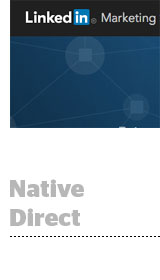 Here’s today’s AdExchanger.com news round-up… Want it by email? Sign-up here.
Here’s today’s AdExchanger.com news round-up… Want it by email? Sign-up here.
LinkedIn Endorses Native
LinkedIn is growing its native ad strategy, with a new option for brands to personalize and test news feed content. LinkedIn’s calling it “Direct Sponsored Content,” and the offering aims to help brands improve the relevancy of their content. Brands can now bypass posting promotional content to company pages, and can publish the ads directly to the LinkedIn news feed. Also noteworthy, brands specify audience segments in order to send personalized in-feed messages. Read the post.
Not So Fast, In-Feed Native
As if on cue following LinkedIn’s “Direct Sponsored Content” update, Yahoo Studio Director Krane Jeffery warned advertisers about confusing the line between in-feed content and native ads. ”In-feed isn’t the same as native,” said Jeffery at the IAB conference in London. “While it might be an effective means for companies to engage with a person, to confuse it with native doesn’t help anybody. Even if you argue that an ad is well targeted, relevant to consumers experience and looks like the surrounding content, you certainly can’t argue that it’s not interruptive.” Read more via The Drum.
Location’s So Last Season
WPP mobile executive Michael Lieberman spoke to Street Fight mag last week at the Place conference in NYC, and what he had to say about location data might [not] surprise you. Lieberman is chief executive NA at Joule, WPP’s global mobile practice. For ad tech in mobile, “Location is already not special,” said Lieberman. “Among the companies that are offering [solutions], very few actually have a technology that is differentiated.” Instead, Lieberman sees a different opportunity for marketers. “You’re going to see a lot of focus on at-retail budgets,” he projected. “Which has been ignored for over a decade. No one has brought the people who run a store any innovation outside of POS in a long time. I do think there’s missed opportunity there.” Read the interview.
Silent Trackers
Mobile advertising startup SilverPush is taking a markedly different approaching to cross-device ad targeting. According to CEO Hitesh Chawla, who spoke to TechCrunch, the company uses what it calls “ultrasonic inaudible sounds” to track consumers and retarget them across multiple devices. An “ultrasonic inaudible sound” is basically a cookie disguised as an audio beacon. When a user surfs the web page, SilverPush can drop the audio beacon on that browser. The browser won’t hear a thing, but the audio device can be used to match browsing behaviors across devices. Chawla acknowledged the “dis” of negative public perception associated with tracking of this caliber. Read more.
Omnicom-Publicis Bennies
MDC Partners reported the strongest quarter in the company’s history on Thursday afternoon, according to Chairman and CEO Miles S. Nadal. Audibly thrilled, Nadal reported a 10.5% increase in revenue, up to $317.7 million from $287.5 million, with organic revenue increasing 7.0%. Interestingly, Nadal attributed some portion of the company’s recent growth to the failed Omnicom-Publicis merger. “We have been a very large beneficiary of both the proposed merger and now the failed merger,” Nadal told investors during the call. “We’ve benefited in three ways. One, we’re picking up talent at an accelerated rate from both of those organizations. We’re also winning significant amounts of new business. The third thing is that during the period that which they were preoccupied, there was no real competition for M&A.” Read the earnings report.
Programmatic OOH
On a quarterly earnings call with analysts, CEO Richard Bressler of out-of-home (OOH) media company CC Media said his company was getting into programmatic buying with the recent hire of Brian Lakamp, the company’s new president of technology and digital ventures. Bressler said that Lakamp will lead development of his company’s tech platform and will “also be responsible for developing our company’s overall strategy and execution related to technology, big data and programmatic buying among other things.” Read the transcript on Seeking Alpha.
You’re Hired!
- Marta Martinez Takes Charge Of AOL Video Sales – Multichannel News
- xAd Appoints Two Industry Veterans To Top Engineering And Sales Positions – press release
- Vserv.mobi Appoints Anurag Patnaik As SVP Product – press release
But Wait. There’s More!
- Elliott Management Takes Significant Stake In IPG – Adweek
- When An Ad Is Not An Ad On Facebook – Digiday
- Twitter’s New User Pitch Means a New Advertising Pitch, Too – Re/code
- Opera Completes Acquisition of AdColony – press release
- InMobi Offers Performance Predictability With Aerospike In-Memory NoSQL Database – press release














